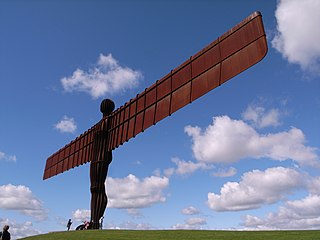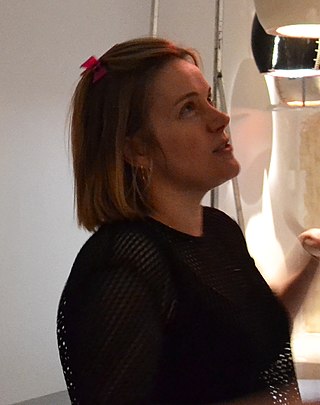
Folkestone is a port town on the English Channel, in Kent, south-east England. The town lies on the southern edge of the North Downs at a valley between two cliffs. It was an important harbour, shipping port & fashionable coastal resort for most part of the 19th and mid 20th centuries.

Tracey Karima Emin is a British artist known for autobiographical and confessional artwork. She produces work in a variety of media including drawing, painting, sculpture, film, photography, neon text and sewn appliqué. Once the "enfant terrible" of the Young British Artists in the 1980s, Tracey Emin is now a Royal Academician.

Sir Antony Mark David Gormley is a British sculptor. His works include the Angel of the North, a public sculpture in Gateshead in the north of England, commissioned in 1994 and erected in February 1998; Another Place on Crosby Beach near Liverpool; and Event Horizon, a multipart site installation which premiered in London in 2007, then subsequently in Madison Square in New York City (2010), São Paulo, Brazil (2012), and Hong Kong (2015–16).

The Angel of the North is a contemporary sculpture by Antony Gormley, located in Gateshead, Tyne and Wear, England. Completed in 1998, it is believed to be the largest sculpture of an angel in the world and is viewed by an estimated 33 million people every year due to its proximity to the A1 and A167 roads and the East Coast Main Line. The design of the Angel, like many of Gormley's works, is based on Gormley's own body. The COR-TEN weathering steel material gives the sculpture its distinctive rusty, oxidised colour. It stands 20 metres (66 ft) tall with a wingspan of 54 metres (177 ft), larger than that of a Boeing 757 aircraft. The vertical ribs on its body and wings act as an external skeleton which direct oncoming wind to the sculpture's foundations, allowing it to withstand wind speeds of over 100 miles per hour (160 km/h).
Sir Roger Michael De Haan, CBE, DL is the son of the late Sidney De Haan, who created the Saga group of companies, best known for selling holidays to the over-50s market. De Haan took over Saga in 1984 when his father retired, and then ran the company with his brother Peter for a further twenty years, launching Saga-branded radio stations to accompany the group's holidays and financial services.

Adelaide Festival Centre, Australia's first capital city multi-purpose arts centre and the home of South Australia's performing arts, was built in the 1970s, designed by Hassell Architects. Located on Kaurna Yarta, the Festival Theatre opened in June 1973 with the rest of the centre following soon after. The complex includes Festival Theatre, Dunstan Playhouse, Space Theatre and several gallery and function spaces. Located approximately 50 metres (160 ft) north of the corner of North Terrace and King William Road, lying near the banks of the River Torrens and adjacent to Elder Park, it is distinguished by its two white geometric dome roofs, and lies on a 45-degree angle to the city's grid.
Outset Contemporary Art Fund is an arts charity established in 2003, and based in London, England.

Cheriton Road is a complex of sports grounds at Folkestone in the English county of Kent. The complex includes football pitches, a cricket ground, hockey pitches, netball courts and an indoor sports facility. It includes the home ground of Folkestone Invicta F.C., known as The Alcaline Stadium for sponsorship reasons, and the Three Hills Sports Park which includes the home grounds of Folkestone Cricket Club and Folkestone Optimist Hockey Club. The cricket ground, which was previously called the Cheriton Road Sports Ground, was used by Kent County Cricket Club for top level cricket matches.
Adam Chodzko is a contemporary British artist, exhibiting internationally. His practice uses a wide range of media, including video, installation, photography, drawing, and performance.

Mike Stubbs is a curator/director and filmmaker based in the UK, currently, the Creative Producer at Doncaster Creates. For 11 years he was the Director/CEO of FACT, the Foundation for Art and Creative Technology, a leading arts organisation for the commissioning and presentation of new media art forms. He has been a key contributor to the development of culture and cultural policy in Liverpool, UK. Stubbs was jointly appointed in May 2007 by Liverpool John Moores University, where he is Professor of Art, Media and Curating. He is father to two daughters Saskia and Lola Czarnecki-stubbs.

Lower Leas Coastal Park is in Folkestone, in Kent, England. The park is split into three broad recreational zones, starting at The Leas Lift and heading west. The formal zone comprises pine avenues and flower gardens, planted for all-year-round interest. The fun zone comprises the large free adventure play area and the amphitheatre. The last area, the wild zone, has been created for a diverse wildlife habitat, with careful management.

Chisenhale Gallery is a non-profit contemporary art gallery based in London's East End. The gallery occupies the ground level of a former veneer factory on Chisenhale Road, situated in the London Borough of Tower Hamlets, near Victoria Park and flanking the Hertford Union Canal. Housed in the same building are two other distinct initiatives: Chisenhale Studios and Chisenhale Dance Space, named also for the road on which they reside.

Art Buff is a graffiti artwork by Banksy which was created in Folkestone in 2014, Banksy announcing it as "part of the Folkestone triennial. Kind of". The work depicts a woman wearing headphones and staring at a plinth, upon which rests a patch of painted-out graffiti. The name of the piece is a play on words, "buff" being a slang term for the painting over of graffiti.

The Creative Folkestone Triennial is an arts festival held every three years in Folkestone, Kent, England.

Emma Hart is an English artist who works in a number of disciplines, including video art, installation art, sculpture, and film. She lives and works in London, where she is a lecturer at Slade School of Art.
Emily Anne Peasgood is an Ivors Composer Awards winning English composer and sound artist. She is the niece of actress and television presenter Julie Peasgood.
Jyll Bradley is an artist based in London. She makes installations, films, drawings and sculptures. She has produced public realm projects such as 'Green/Light ' (2014) commissioned by the Folkestone Triennial, and 'Dutch Light' (2017) commissioned by Turner Contemporary (Margate).

Creative Folkestone Quarterhouse is a performance and exhibition space in Folkestone, Kent, England. It is used for activities including theatre, dance, music, film, comedy, family shows, and live screenings from organisations including National Theatre and Royal Opera House. The venue is also home to numerous festivals, including Creative Folkestone Book Festival, Normal? Festival of the Brain, and SALT Festival of the Sea and Environment.
The Creative Folkestone Book Festival is an annual event held in Folkestone, Kent, England. The 2021 edition is scheduled to be held 4–13 June 2021.
Folkestone’s outdoor public art exhibition – Folkestone Artworks – is the UK’s largest urban outdoor contemporary art exhibition, consisting of 74 contemporary artworks by 46 artists in scenic locations around the town and its coastline. Artworks include those by Lubaina Himid, Tracey Emin, Yoko Ono and Antony Gormley. Folkestone Artworks is refreshed every three years, as permanent works commissioned for the Folkestone Triennial are incorporated. Folkestone Artworks is maintained and cared for by Creative Folkestone on behalf of the Roger De Haan Charitable Trust.













